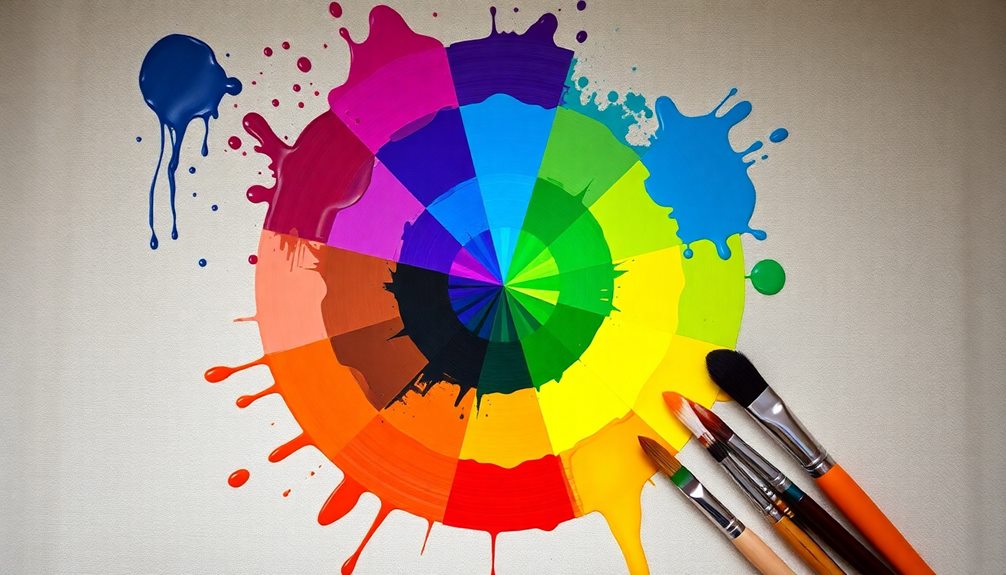Critical theory offers you various lenses to interpret art by examining how it reflects, challenges, or reinforces social power structures. It encourages you to question who benefits from the messages art conveys and who might be marginalized. You’ll explore how art is shaped by social and political contexts, revealing underlying ideologies and power dynamics. If you’re curious about uncovering hidden messages and understanding art’s societal role, you’ll find these different perspectives incredibly insightful.
Key Takeaways
- Critical theory examines how power relations and social inequalities influence art’s meaning and societal impact.
- It encourages questioning dominant ideologies and revealing underlying messages that reinforce social hierarchies.
- Analyzing social and political contexts helps interpret how art reflects or challenges existing power structures.
- Art serves as both a reflection of societal values and a tool for ideological critique or resistance.
- Different lenses, such as ideological critique or cultural analysis, enable deeper understanding of art’s role in society.

Have you ever wondered how society’s power structures shape our beliefs and behaviors? Critical theory invites you to explore these questions by examining the underlying power dynamics that influence not only institutions but also individual perceptions. When you approach art through this lens, you’re encouraged to look beyond surface meanings and contemplate how cultural artifacts serve to reinforce or challenge dominant ideologies. Power dynamics are at the core of critical theory’s approach; they reveal who holds authority and how that authority maintains social inequalities. Art becomes a site where ideological critique can be applied, exposing messages that perpetuate stereotypes, oppression, or marginalization. Instead of accepting art at face value, critical theory urges you to analyze who benefits from its messages and who might be silenced or marginalized by them. You begin to see that art isn’t created in a vacuum but is deeply embedded in the social and political context of its time. By examining these contexts, you can uncover hidden power relations that shape public consciousness and influence cultural norms. For instance, a painting, film, or literary work might appear neutral or purely aesthetic, but an ideological critique reveals how it reproduces certain worldviews aligned with dominant classes or political interests. Incorporating social context into your analysis allows for a more comprehensive understanding of the artwork’s meaning and impact. This perspective helps you understand that art can serve as a tool for ideological reinforcement or resistance. It’s about questioning the status quo and recognizing that cultural productions often reflect the interests of those in power. Critical theory encourages you to think critically about whose voices are heard and whose are suppressed within these cultural narratives. As you analyze art through this lens, you become more aware of how cultural forms are used to maintain social hierarchies or to challenge them. This approach doesn’t dismiss art’s beauty or artistic value but asks you to consider the broader social implications behind its creation and reception. It also emphasizes the importance of cultural hegemony in shaping societal perceptions and narratives. This pushes you to ask uncomfortable questions about the messages embedded within artworks and the societal forces that shape their meaning. By engaging with power dynamics and ideological critique, you gain a deeper understanding of how art functions not just as personal expression but as a reflection and reinforcement of social structures. This awareness empowers you to interpret art more critically, recognizing its potential as both a mirror and a weapon in ongoing struggles over power and meaning. Ultimately, critical theory helps you see art as an essential part of the cultural landscape—one that can either uphold the status quo or challenge it, depending on how you choose to interpret and engage with it.
Frequently Asked Questions
How Does Critical Theory Influence Contemporary Art Analysis?
Critical theory shapes how you analyze contemporary art by highlighting power dynamics and exploring underlying ideological critiques. You’re encouraged to look beyond surface appearances, questioning who benefits from certain representations and how social structures influence the work’s meaning. This perspective pushes you to see art as a reflection of societal power struggles, helping you uncover hidden messages and challenge dominant ideologies in your interpretation.
Can Critical Theory Be Applied to Digital and New Media Art?
Did you know that over 80% of art is now experienced digitally? Critical theory definitely applies to digital and new media art. You can explore digital aesthetics and challenge traditional ideas through an interactive critique, revealing power structures and societal issues. By analyzing how technology shapes art, you deepen your understanding of digital culture and foster critical thinking about the impact on society and individual perception.
What Are the Limitations of Using Critical Theory in Art Interpretation?
You might find that using critical theory in art interpretation has limitations, like subjectivity bias, where personal views color your understanding. It can also lead to interpretive rigidity, making it hard to see alternative meanings. While critical theory offers valuable insights, it may restrict your perspective by emphasizing certain ideas over others, so it is vital to balance it with open-mindedness to fully appreciate the complexity of art.
How Do Cultural Differences Impact Critical Theory Perspectives?
You see that cultural differences shape your interpretive frameworks and influence how you perceive art. Your cultural identity informs what symbols, themes, and meanings resonate with you, which can lead to diverse interpretations. These differences remind you that art isn’t universal; your background impacts how you analyze and appreciate works. Embracing this diversity enriches your understanding and highlights the importance of considering multiple perspectives in art interpretation.
What Are the Key Thinkers Behind Different Critical Lenses?
You’re diving into a whirlwind of ideas! Key thinkers behind different critical lenses include Marxist thinkers like Karl Marx, who focus on economic power and class struggle, and feminist theorists such as Simone de Beauvoir, who explore gender inequality. These minds revolutionize how you interpret art, revealing hidden social structures and biases. Their insights challenge you to see beyond surface appearances and understand the deeper forces shaping society and art alike.
Conclusion
Now that you’ve explored different lenses of critical theory, you’re equipped to see art as a multifaceted mirror reflecting society’s complexities. Like a prism revealing hidden colors, these perspectives allow you to uncover deeper meanings behind creative works. Embrace these tools to analyze art critically, transforming your viewing experience from surface-level appreciation to a profound dialogue. Remember, each lens is a key revealing new worlds within every piece—wait not to turn that key and explore!









